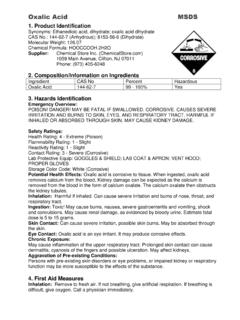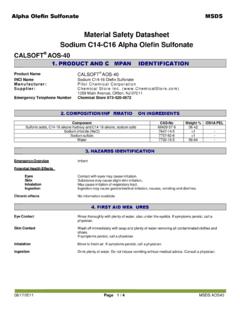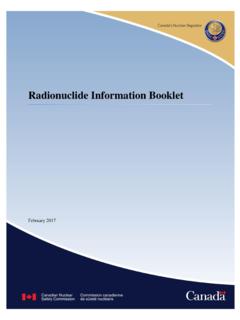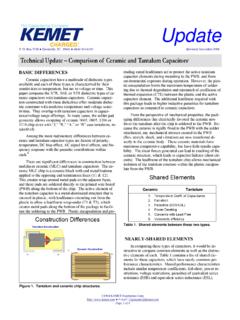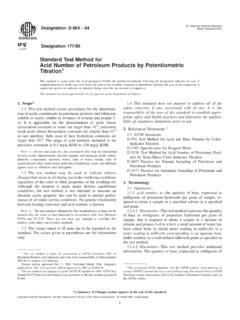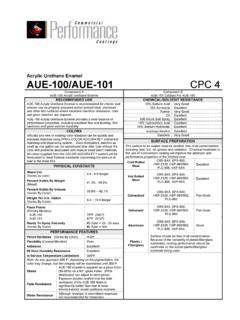Transcription of Citric Acid Anhydrous Material Safety Data Sheet
1 North America (OSHA/GHS and WHMIS Compliant) Page 1 / 7 Citric acid Anhydrous Material Safety Data Sheet Transport Symbol WHMIS NFPA Personal Protective Equipment Original Preparation Date: 15-Apr-2009 Revision Date: 12-Nov-2012 Revision Number: 1 1. IDENTIFICATION OF THE SUBSTANCE/PREPARATION AND THE COMPANY/UNDERTAKING Product Name: Citric acid Anhydrous Synonyms: 2-hydroxy-1,2,3-propanetricarboxylic acid , or 2-hydroxypropane-1,2,3-tricarboxylic acid . Product Code: C001, 020410, 020420, 020440 Use of the Substance / Preparation: Chemical intermediate.
2 Personal care products. Cleaning/detergent products and other household products. Paper products. Construction products. Polymers and plastics products. Oil industry. Textile industry. Paints and coatings. Photography products. Laboratory reagents. Water treatment. Treatment of metal surfaces. Agricultural applications. Medical devices. Food additive. - - - - - - - - - - - - - - - - - - - - - - - - - - - - - - - - - - - - - - - - - - - - - - - - - - - - - - - - - - - - - - - - - - - - - - - - - - - - - - - - - - - - - - - - - Contact Supplier: Chemical Store Inc. 1059 Main Avenue Clifton, NJ 07011, USA Telephone Number: (+1) 973-405-6248 Emergency response telephone number: Chemtrec 1-800-424-9300 (CCN 1635) 2.
3 HAZARDS IDENTIFICATION Emergency Overview Warning. Irritating to eyes. Corrosive to metals (as aqueous solution). Product dust may cause mild, mechanical irritation. May form combustible dust concentrations in air. Appearance White Physical State Solid: Powder / Granular Odor Odorless Classification according to 29 CFR 1910, amended to conform to the United Nations' Globally Harmonized System of Classification and Labelling of Chemicals (GHS): Serious Eye Damage / Eye Irritation Category 2 Hazards Not Otherwise Classified Combustible Dust GHS Label Elements Signal Word: Warning GHS Hazard Pictogram(s): Hazard Statement(s): H319 Causes serious eye irritation May form combustible dust concentrations in air.
4 Precautionary Statement(s): Prevention Precautionary Statement(s): Wash hands and exposed skin thoroughly after handling. Wear eye protection. Response Precautionary Statement(s): If in eyes: Rinse cautiously with water for several minutes. Remove contact lenses, if present and easy to do. Continue rinsing. If eye irritation persists: Get medical advice. North America (OSHA/GHS and WHMIS Compliant) Page 2 / 7 020410, 020420, 020440 - Citric acid Anhydrous Revision Date: 12-Nov-2012 3. COMPOSITION/INFORMATION ON INGREDIENTS Chemical nature of the preparation Substance Chemical Family Acids Molecular Formula C6H8O7 The following component(s) in this product are considered hazardous under applicable OSHA (USA), WHMIS (Canada), and/or NOM-002-SCT-2003 (Mexico) regulations Chemical Name CAS-No Weight % North American Hazard Indicator Citric acid 77-92-9 99-100 OSHA / GHS: Eye Irrit.
5 2; WHMIS: E 4. FIRST AID MEASURES Description of first aid measures General Advice If symptoms persist, call a physician. Show this Safety data Sheet to the doctor in attendance. Use personal protective equipment. For personal protection see section 8. Eye Contact Immediately flush with plenty of water. After initial flushing, remove any contact lenses and continue flushing for at least 15 minutes. If symptoms persist, call a physician. Skin Contact Wash off immediately with soap and plenty of water removing all contaminated clothes and shoes. Inhalation Move to fresh air. Ingestion Clean mouth with water and afterwards drink plenty of water.
6 Protection of First-aiders Use personal protective equipment. Avoid contact with skin, eyes and clothing. Most important symptoms and affects, both acute and delayed Eyes Irritating to eyes. Contact with eyes may cause mechanical irritation. Skin According to GHS hazard classification criteria, the product is not considered as being a skin irritant. Product dust may cause mild, mechanical irritation. Health injuries are not known or expected under normal use. Inhalation May cause irritation of respiratory tract. Based on the low pH, Citric acid would be expected to cause irritation to the respiratory tract, resulting in a higher cough response as the inhalation exposure concentration was increased.
7 Ingestion Oral exposure is not anticipated under normal working conditions. Health injuries are not known or expected under normal use. Main Symptoms Itching. Redness. Burning sensation. Indication of any immediate medical attention and special treatment needed Notes to Physician Treat symptomatically. 5. FIRE-FIGHTING MEASURES Flammable Properties Fine dust dispersed in air may ignite. Risk of ignition followed by flame propagation or secondary explosions should be prevented by avoiding accumulation of dust, on floors and ledges. Extinguishing media Suitable Extinguishing Media Dry chemical.
8 Carbon dioxide (CO2) Water spray. Foam. Use extinguishing measures that are appropriate to local circumstances and the surrounding environment. Unsuitable Extinguishing Media No information available. Special hazards arising from the substance or mixture Hazardous Combustion Products Thermal decomposition can lead to release of irritating gases and vapors, Carbon monoxide (CO), Carbon dioxide (CO2). Specific Hazards Arising from the Chemical None known. Sensitivity to mechanical impact No. Sensitivity to static discharge Yes. (as dust). Further information Fine dust dispersed in air may ignite.
9 Dust explosibility class = 1. Weak to moderately explosible. North America (OSHA/GHS and WHMIS Compliant) Page 3 / 7 020410, 020420, 020440 - Citric acid Anhydrous Revision Date: 12-Nov-2012 Advice for fire-fighters Protective Equipment and Precautions for Firefighters As in any fire, wear self-contained breathing apparatus pressure-demand, MSHA/NIOSH (approved or equivalent) and full protective gear. NFPA Health 1 Flammability 1 Stability and Reactivity 0 Physical hazard None known 6. ACCIDENTAL RELEASE MEASURES Personal Precautions Avoid contact with the skin and the eyes.
10 Use personal protective equipment. For personal protection see section 8. Avoid dust formation. Environmental Precautions Prevent further leakage or spillage if safe to do so. Prevent product from entering drains. Methods for Clean-up Pick up and transfer to properly labelled containers. Avoid dust formation. Keep in suitable, closed containers for disposal. Aqueous spillage should be neutralized and treated prior to discharge. For disposal information see section 13. 7. HANDLING AND STORAGE Handling Wear personal protective equipment. Avoid contact with skin, eyes and clothing. Handle in accordance with good industrial hygiene and Safety practice.
